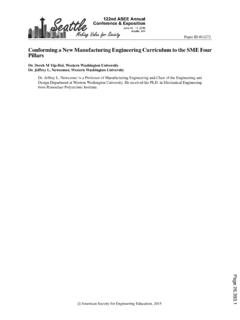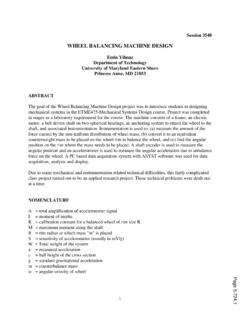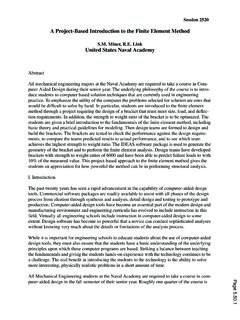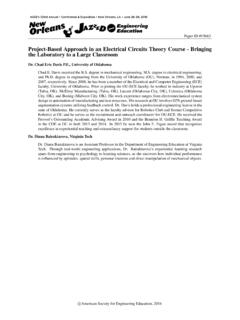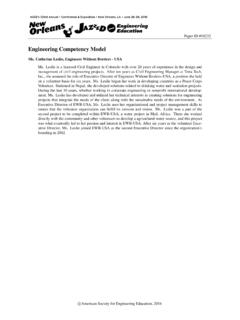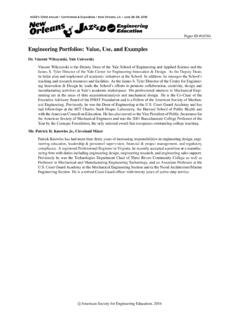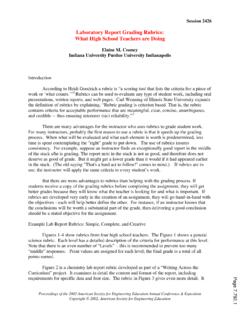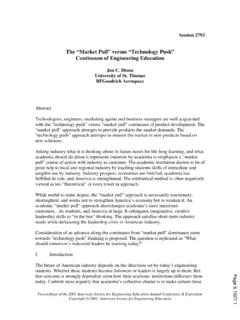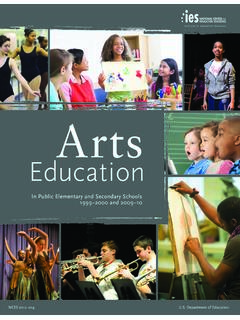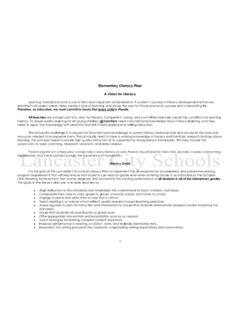Transcription of Kinesthetic Learning In The Classroom
1 AC 2008-599: Kinesthetic Learning IN THE CLASSROOMJoe Tranquillo, Bucknell UniversityJOSEPH V TRANQUILLO is an assistant professor of biomedical and electrical engineering atBucknell University. Dr. Tranquillo teaches courses primarily in bioinstrumentation. His researchfocuses on theoretical and computational models of electrical activity in the body. American Society for Engineering Education, 2008 Page Learning in the Classroom Great ideas originate in the muscles Thomas Edison Introduction A great deal of information exists regarding the different means by which students learn new concepts. Although visual, auditory and Kinesthetic Learning are the most commonly listed Learning styles, little attention has been given to Kinesthetic Learning .
2 This is especially true in lecture-based courses at the college level where the format favors verbal and visual learners. Here we make a tentative argument for the value of including Kinesthetic Learning activities in lecture-based classes as a vehicle for teaching concepts. To begin, it is important to make clear how our working definition of Kinesthetic Learning may be different from previous work. First, the term active Learning already means something to the education community and may include instructor demonstrations, brainstorming, reflections and minute papers. The version of Kinesthetic Learning considered here is a sub-set of active Learning where students will be out of their seats and quite literally active.
3 Second, the term Kinesthetic Learning is in common use in some education circles. Within those circles, the focus is typically on Learning a manual skill or refining muscle coordination. Engineers must learn to build physical structures, often using their hands to perform complex tasks. While a great deal of Learning takes place in becoming competent at wire wrapping and soldering a circuit board, connecting and sealing tubes in a flow loop or drilling a precise hole in a section of sheet metal, the Learning is largely a fine tuning of muscle memory. In most curricula, these skills are practiced and mastered in a lab setting. The version of Kinesthetic Learning considered here will take place in the Classroom with the objective of introducing and strengthening concepts as well as connecting ideas together.
4 Therefore, when the terms, active or activity appear below, they quite literally mean some type of physical activity that is intended to stimulate deep thinking. We first review some relevant literature, followed by an outline of a generic activity, an illustrative example, suggestions for generating ideas and designing activities, and finally student and instructor observations. Games lubricate the body and the mind Benjamin Franklin What is Known about Kinesthetic Learning Kinesthetic Learning is often listed in surveys of Learning styles along side, verbal and visual Learning . Despite this recognition as an important Learning style, Kinesthetic activities have not received much attention at the college level.
5 In fact, the degree to which physical activity is present in the Classroom appears to drop to nearly zero as students progress from primary to secondary to post-secondary school. Below we summarize some of the work that has been conducted on the effectiveness of Kinesthetic Learning . Page 2 Primary and Secondary School Jean Piaget All of the most basic facts about the world are first discovered through physical means. As the brain matures, facts are abstracted and related to other concepts. Although the ability to abstract a concept and make complex connections between concepts are considered to be signatures of a mature mind, humans learn best by doing something concrete first, and then abstracting to more general concepts.
6 Dunn and Dunn - "Children enter kindergarten as Kinesthetic and tactual learners, moving and touching everything as they learn. By second or third grade, some students have become visual learners. During the late elementary years some students, primarily females, become auditory learners. Yet, many adults, especially males, maintain Kinesthetic and tactual strengths throughout their lives." Feldman and McPhee Kinesthetic learners are most successful when totally engaged with a Learning activity. They acquire information fastest when participating in a science lab, drama presentation, skit, field trip, dance, or other active activity. Because of the high numbers of Kinesthetic learners, education is shifting toward a more hands-on approach; manipulatives and other props are incorporated into almost every school subject, from physical education to language arts.
7 Hands-on teaching techniques are gaining recognition because they address the challenging needs of Kinesthetic learners, as well as the diverse needs of auditory and visual learners. Muneera Spence - Visual learners account for around 30% of the population and auditory learners account for around 25% of the population. Kinesthetic learners may account for as much as 45% of the population. Benjamin Bloom In addition to cognitive and affective taxonomies, Bloom (as well as Dave and Harrow) developed a psychomotor taxonomy. The taxonomy ranges from basic proprioception to the ability to improvise new and complex movement. Howard Gardner Intelligence is a multifaceted quality that cannot be measured by a single score on a test.
8 Furthermore, some types of intelligence are not even located in the brain. For example, an understanding of space and motion is a distinct kind of intelligence that is useful to the athlete, dancer, martial artist and engineer. Post-Secondary School Although many engineers are acknowledged to be Kinesthetic learners, there is little data to support this claim. Furthermore, the distinction between an activity as a means of Learning a skill ( lab skills) versus Learning a concept, has not been addressed in any study. Instruments such as Felder s Index of Learning Styles (ILS) come the closest to assessing the definition of active prescribed here. In a survey of thousands of college-age engineering majors, 67% reported that they process information best by being active.
9 The term active in the ILS, however, is contrasted with reflective . When the template for a Kinesthetic activity is explained below, it will be clear that both active and reflective elements are involved and tightly integrated. Page 3 Despite the lack of data in the engineering education field, some educators, such as those in dance, graphic arts, and communications, use Kinesthetic Learning daily. In a study on graphic arts education, where one would expect a high percentage of visual learners, it was estimated that 45% of students were categorized as Kinesthetic learners. Furthermore, Kinesthetic activities have been found to be effective in special adult populations, such as the blind and deaf.
10 It should be noted, however, that these fields place emphasis on refining muscle memory and conditioning responses. Two studies in English and Computer Science, however, did use Kinesthetic Learning to teach concepts. Virginia Zimmerman guides students in developing dance steps that correspond to the rhythm of a poem. The purpose is to highlighting the use of meter and structure by different authors, and point out how they sometimes violate the structure for effect. A small group of computer science faculty have also been building a repository of Kinesthetic Learning activities at ~ that demonstrate a wide range of sorting and networking algorithms. A Subset of Active Learning Kinethetic Learning is a type of active Learning in that students are quite literally participating in their education.


